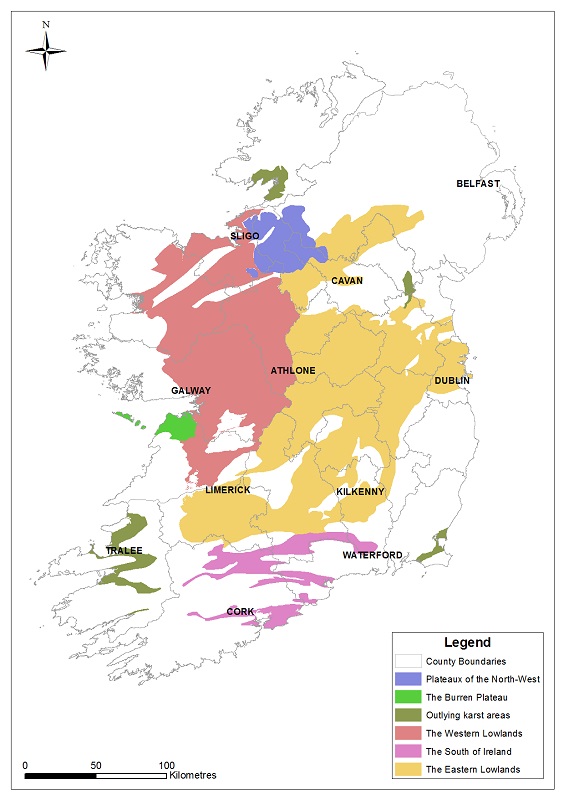Distribution of Irish Karst
Carboniferous limestone outcrops in all the counties of the Republic of Ireland with the exception of County Wicklow. Karst features have been recorded for all other counties except for Wexford and Carlow, both of which have only very small areas of limestone bedrock. However, it is probably the case that all limestone of reasonable purity in Ireland has been karstified to some degree, though without this necessarily being manifested in terms of karst landforms, particularly in areas where bedrock is overlain by thick subsoils.
Most karst landforms in Ireland are found in the West of Ireland. The nature of the limestone strongly influences its susceptibility to karstification. Pure bedded limestones are more susceptible to karstification and contain most karst landforms than impure (or mud or shale-rich) limestones. Geological structure also has a major influence on the development of karstification: Bedding, folding and fracturing of the limestone gives rise to more openings for the water to penetrate and begin to dissolve the rock. The degree of karstification is significantly reduced where there are inter-bedded shale layers which restrict water movement and where very strong deformation causes re-sealing of fractures with crystalline calcite.

The importance of Karst in Ireland
- Karst limestones are important sources of water
- Karst groundwater supports river and lake systems
- Karst aquifers give rise to important ecosystems
- Karst landscapes are important for geoheritage and tourism
- Karst regions contain sites of archaeological and scientific importance
- Karst limestone is often encountered in civil engineering projects
- Karst limestones are vulnerable to pollution and need special protection measures
The main karst regions in Ireland
There is an obvious distinction between upland karst areas in Ireland, such as the Burren and low-lying karst areas, such as the Western Lowlands of East Galway. Lowland karsts are the more extensive: approximately 80% of the outcrop of Carboniferous limestone lies at an altitude of less than 100 m O.D. and approximately 95% at an altitude of less than 150 m O.D. The upland, or plateau, karsts (the Burren and the uplands of Sligo, Leitrim, Cavan and Fermanagh) are located at the margin of the lowland karsts.
The lowlands, particularly west of the River Shannon, are blanked by Quaternary and earlier deposits over much of their extent, with the cover thinning westwards. Lowland karsts are probably the most developed and complex karst regions of Ireland. Despite the fact that lowland karst underlies many of the most economically significant areas of the country, with the most developed agriculture and the highest demands for water, its hydrogeology is apparently complicated and is less than fully understood. Characteristic of the lowland karsts are:
- Low hydraulic gradients but with flow rates, typically 50-100 m/h
- Numerous springs with discharges of 10-100 l/s and with contributing areas, not always easy to delimit, of tens of km2
- Flow paths from recharge to discharge areas of hundreds of metres, to tens of kilometres
- Complicated interactions with surface drainage systems, lakes and rivers
However, Ireland's karst can be further subdivided into 6 main areas, with two upland and three lowland 'regions' delineated, as well as some outliers worthy of note. These areas are shown below. It should be noted that the subdivisions of the lowland karst areas are to some extent arbitrary.

The Main karst regions are:
- The Burren Plateau
- Plateaux of the North-West
- The Western Lowlands
- The Eastern Lowlands
- Southern Valley Karst